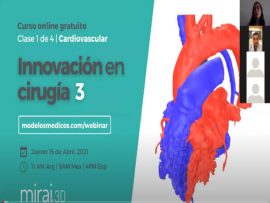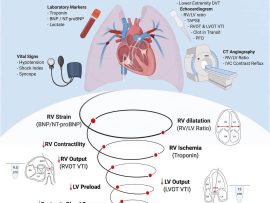El Dr. Norberto Berber, el Dr. Mariano Vrancic y el Dr. Jesús Pinzás, nos cuentan cómo utilizan impresión 3D y realidad aumentada para planificar cirugías complejas y simular procedimientos en..
Read MoreAbstract Purpose of review Acute pulmonary embolism (PE) is a heterogeneous disease process whose presentation varies widely between individuals who are asymptomatic, develop cardiogenic shock, or experience acute PE-related mortality...
Read MoreAbstract Heart failure (HF) is a leading cause of morbidity and mortality in pregnant women in the United States. Although peripartum cardiomyopathy is the most common diagnosis for pregnant women..
Read MoreAbstract In 2018, the position paper ‘Imaging the adult with congenital heart disease: a multimodality imaging approach’ was published. The paper highlights, in the first part, the different imaging modalities..
Read MoreAbstract In this document, we propose a universal definition of heart failure (HF) as a clinical syndrome with symptoms and/or signs caused by a structural and/or functional cardiac abnormality and..
Read MoreAbstract Cardioaortic embolism to the brain accounts for approximately 15–30% of ischaemic strokes and is often referred to as ‘cardioembolic stroke’. One-quarter of patients have more than one cardiac source..
Read MoreAbstract In the early years of 2000, a growing enthusiasm toward robotic and minimally invasive techniques became more prevalent in the field of cardiac surgery. Robotically assisted surgical systems were..
Read MoreAbstract Objective Isolated tricuspid surgery through median sternotomy can be associated with a high morbidity and mortality. Reports of minimally invasive isolated tricuspid valve operations are rare, but the outcomes..
Read MoreAbstract Efforts to reduce the trauma and discomfort associated with thoracic and cardiac procedures in children have a long and complex history. While much of the early focus has been..
Read MoreAbstract Extracorporeal life support and extracorporeal membrane oxygenation (ECMO) are widely used for acute severe refractory cardiac and respiratory failure. An increasing number of patients are treated with ECMO worldwide. This can be attributed to..
Read MoreAbstract The transfusion of platelets for both prophylaxis and treatment of bleeding is relevant to all areas of medicine and surgery. Historically, guidance regarding platelet transfusion has been limited by..
Read MoreAbstract WHAT IS the purpose of trial registration and why is it so important to the integrity of research? Clinical trial registration serves the following purposes. First, by preregistering the..
Read MoreAbstract Extracorporeal circuits including renal replacement therapy, extracorporeal membrane oxygenation, and ventricular assist devices are increasingly used in critically ill patients. The need for anticoagulation to provide circuit patency and..
Read MoreAbstract Development of minimally invasive cardiac surgery (MICS) served the purpose of performing surgery while avoiding the surgical stress triggered by a full median sternotomy. Minimizing surgical trauma is associated..
Read MoreAbstract Background The ongoing coronavirus disease 2019 (Covid-19) pandemic presents challenges for surgeons of all disciplines, including cardiologists. The volume of cardiac surgery cases has to comply with the mandatory..
Read MoreAbstract Background Postoperative respiratory failure, defined as ventilator dependency for more than 48 hours or unplanned reintubation within 30 days, is a costly complication of cardiac surgery that increases mortality..
Read MoreAbstract Extracorporeal membrane oxygenation (ECMO) represents an established technique to provide temporary cardiac and/or pulmonary support. ECMO, in veno-venous, veno-arterial or in extracorporeal carbon dioxide removal modality, is associated with..
Read MoreAbstract The aim of this article is to provide a comprehensive review of the current state of knowledge on heparin-induced thrombocytopenia (HIT) in cardiac surgery. The management of HIT patients..
Read MoreVarón de 65 años. Exfumador, hipertenso, dislipémico y diabético en tratamiento con antidiabéticos orales. Síndrome de apnea obstructiva del sueño en tratamiento con CPAP. Cardiopatía isquémica que debuta con ángor..
Read More



















